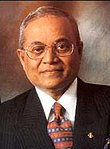Maldivian presidential election, 2008
|
|
||||||||||||||||||||||||||
|
||||||||||||||||||||||||||
|
||||||||||||||||||||||||||
|
||||||||||||||||||||||||||
Presidential elections were held in the Maldives in two rounds on October 8 and 28, 2008. No candidate gained more than 50% of the vote in the first round on October 8; incumbent president Maumoon Abdul Gayoom fared best with about 40%. A runoff was thus held on October 28 between Gayoom and second-placed Mohamed Nasheed. Nasheed won the election, unseating longtime incumbent Gayoom.
The election was the first one held democratically in the history of the Maldives.
The election was initially planned to be held on October 4, but had to be delayed after the Majlis (national assembly) did not pass necessary reforms on time.
The incumbent, President Gayoom, in power since 1978, ran for another five-year term. According to the new Constitution, which came into effect on August 7, 2008, Gayoom had served the maximum number of terms allowed (two). He argued that since the election was held under a new constitution, the previous terms did not count toward the limit. The Supreme Court agreed that the limited terms were to be served "under this Constitution" and that Gayoom was therefore eligible to run in the election.
On August 25, 2008, the Maldives National Congress and the Adhaalath Party announced that they would support Republican Party candidate Qasim Ibrahim. On September 3, 2008, the six candidates participated in a televised debate.
There were 208,252 eligible voters in the Maldives in the first round, which is roughly 60% of the population. There were a total 396 polling stations throughout the country. Additionally, registered Maldivians living in Colombo, Thiruvananthapuram, Kuala Lumpur and Singapore were permitted to vote in Maldivian embassies and consulates.
...
Wikipedia


